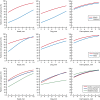Clinical relevance is associated with allergen-specific wheal size in skin prick testing
- PMID: 24283409
- PMCID: PMC4215109
- DOI: 10.1111/cea.12240
Clinical relevance is associated with allergen-specific wheal size in skin prick testing
Abstract
Background: Within a large prospective study, the Global Asthma and Allergy European Network (GA(2) LEN) has collected skin prick test (SPT) data throughout Europe to make recommendations for SPT in clinical settings.
Objective: To improve clinical interpretation of SPT results for inhalant allergens by providing quantitative decision points.
Methods: The GA(2) LEN SPT study with 3068 valid data sets was used to investigate the relationship between SPT results and patient-reported clinical relevance for each of the 18 inhalant allergens as well as SPT wheal size and physician-diagnosed allergy (rhinitis, asthma, atopic dermatitis, food allergy). The effects of age, gender, and geographical area on SPT results were assessed. For each allergen, the wheal size in mm with an 80% positive predictive value (PPV) for being clinically relevant was calculated.
Results: Depending on the allergen, from 40% (blatella) to 87-89% (grass, mites) of the positive SPT reactions (wheal size ≥ 3 mm) were associated with patient-reported clinical symptoms when exposed to the respective allergen. The risk of allergic symptoms increased significantly with larger wheal sizes for 17 of the 18 allergens tested. Children with positive SPT reactions had a smaller risk of sensitizations being clinically relevant compared with adults. The 80% PPV varied from 3 to 10 mm depending on the allergen.
Conclusion: These 'reading keys' for 18 inhalant allergens can help interpret SPT results with respect to their clinical significance. A SPT form with the standard allergens including mm decision points for each allergen is offered for clinical use.
Keywords: allergy diagnostics; common allergens; sensitization; skin prick test.
© 2013 The Authors. Clinical & Experimental Allergy published by John Wiley & Sons Ltd.
Figures



Similar articles
-
GA(2)LEN skin test study II: clinical relevance of inhalant allergen sensitizations in Europe.Allergy. 2009 Oct;64(10):1507-1515. doi: 10.1111/j.1398-9995.2009.02089.x. Allergy. 2009. PMID: 19772516
-
Standard skin prick testing and sensitization to inhalant allergens across Europe--a survey from the GALEN network.Allergy. 2005 Oct;60(10):1287-300. doi: 10.1111/j.1398-9995.2005.00895.x. Allergy. 2005. PMID: 16134996
-
GA(2)LEN skin test study I: GA(2)LEN harmonization of skin prick testing: novel sensitization patterns for inhalant allergens in Europe.Allergy. 2009 Oct;64(10):1498-1506. doi: 10.1111/j.1398-9995.2009.02093.x. Allergy. 2009. PMID: 19772515
-
The skin prick test.J Biol Regul Homeost Agents. 2018 Jan-Feb;32(1 Suppl. 1):19-24. J Biol Regul Homeost Agents. 2018. PMID: 29552869 Review.
-
Allergen Testing: A Review of the Indications, Procedures, and Limitations in Ocular Allergy.Clin Rev Allergy Immunol. 2024 Dec;67(1-3):1-20. doi: 10.1007/s12016-024-09002-5. Epub 2024 Sep 14. Clin Rev Allergy Immunol. 2024. PMID: 39276294 Review.
Cited by
-
House Dust Mite Allergens: New Discoveries and Relevance to the Allergic Patient.Curr Allergy Asthma Rep. 2016 Sep;16(9):69. doi: 10.1007/s11882-016-0649-y. Curr Allergy Asthma Rep. 2016. PMID: 27600386 Review.
-
Causal Relationship Between Anti-TPO IgE and Chronic Urticaria by In Vitro and In Vivo Tests.Allergy Asthma Immunol Res. 2019 Jan;11(1):29-42. doi: 10.4168/aair.2019.11.1.29. Allergy Asthma Immunol Res. 2019. PMID: 30479075 Free PMC article.
-
Prevalence of allergic and nonallergic rhinitis in a rural area of northern China based on sensitization to specific aeroallergens.Allergy Asthma Clin Immunol. 2018 Nov 21;14:77. doi: 10.1186/s13223-018-0299-9. eCollection 2018. Allergy Asthma Clin Immunol. 2018. PMID: 30479630 Free PMC article.
-
Management of the polyallergic patient with allergy immunotherapy: a practice-based approach.Allergy Asthma Clin Immunol. 2016 Jan 11;12:2. doi: 10.1186/s13223-015-0109-6. eCollection 2016. Allergy Asthma Clin Immunol. 2016. PMID: 26759555 Free PMC article. Review.
-
International Consensus Statement on Allergy and Rhinology: Allergic Rhinitis.Int Forum Allergy Rhinol. 2018 Feb;8(2):108-352. doi: 10.1002/alr.22073. Int Forum Allergy Rhinol. 2018. PMID: 29438602 Free PMC article.
References
-
- Demoly P, Romano A, Bousquet J. In vivo methods for the study of allergy. In: Adkinson NF, Yunginger JW, Busse WW, Bochner BS, Simons FER, Holgate ST, editors. Middleton's allergy, principles and practice. 7th edn. Philadelphia, PA: Elsevier Inc; 2008. pp. 1267–80.
-
- Burbach GJ, Heinzerling LM, Edenharter G, et al. GA2LEN skin test study II: clinical relevance of inhalant allergen sensitizations in Europe. Allergy. 2009;64:1507–15. - PubMed
-
- Bousquet J, Khaltaev N. Global surveillance, prevention and control of chronic respiratory diseases. A comprehensive approach. Global alliance against chronic respiratory diseases. Geneva: World Health Organization; ISBN 978 92 4 156346 8 2007:148.
-
- Bock S, Buckley J, Holst A, May C. Proper use of skin tests with food extracts in diagnosis of food hypersensitivity. Clin Allergy. 1978;8:559–64. - PubMed
-
- Sampson HA. Utility of food-specific IgE concentrations in predicting symptomatic food allergy. J Allergy Clin Immunol. 2001;107:891–6. - PubMed
Publication types
MeSH terms
Substances
Grants and funding
LinkOut - more resources
Full Text Sources
Other Literature Sources

